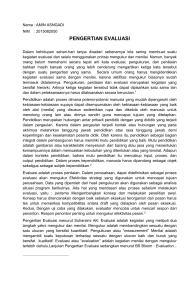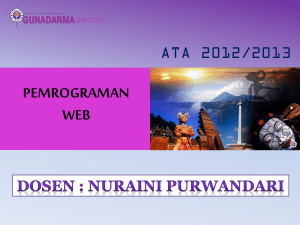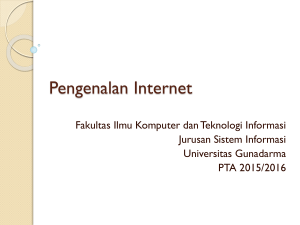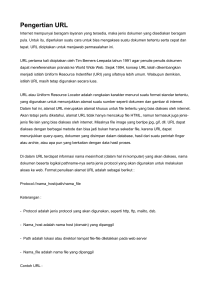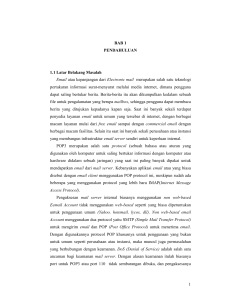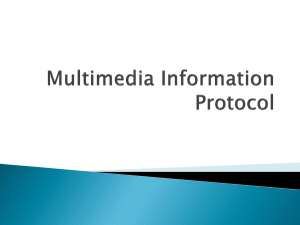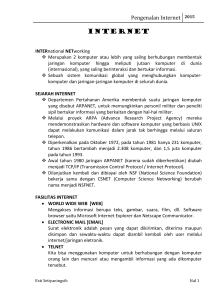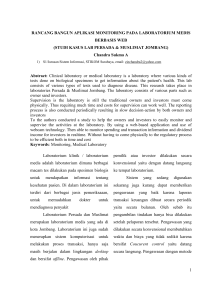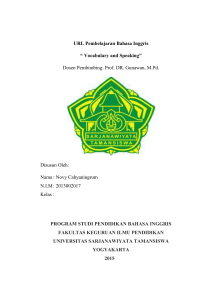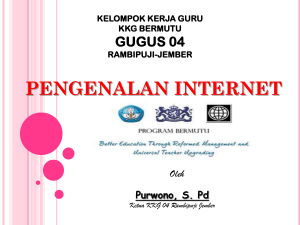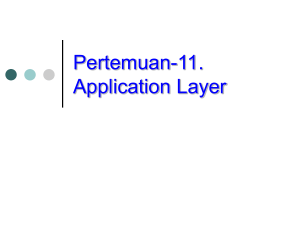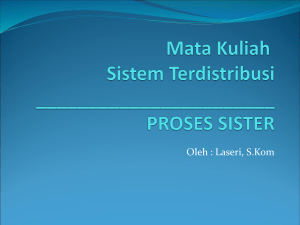pengantar teknologi web
advertisement
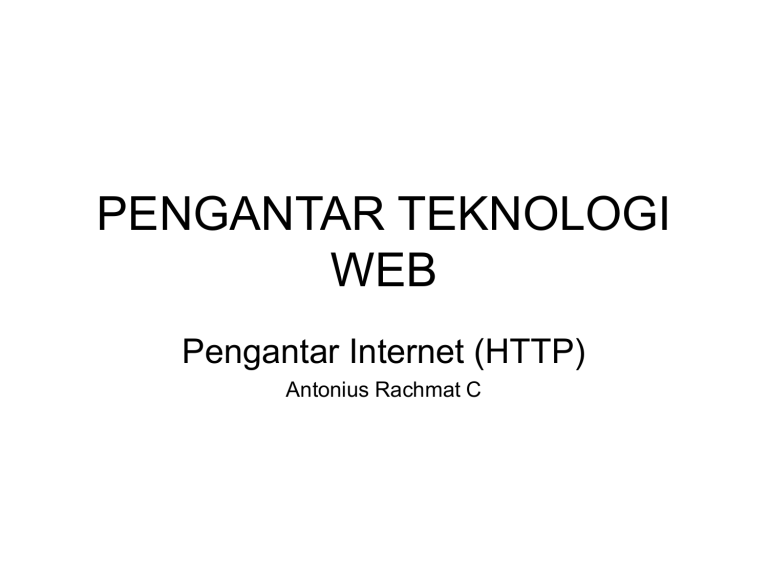
PENGANTAR TEKNOLOGI WEB Pengantar Internet (HTTP) Antonius Rachmat C LAN • LAN consists of the following components: – LAN file server is a repository of various software and data files for the network (optional) – Nodes are the client machines on the LAN – Wired or wireless communication media that connects the devices • LAN network interface card (NIC) is a special adapter that links an individual device to the communication medium and specifies: – The rate of data transmission; – The size of the message units; – Addressing information attached to each message – The network topology WAN + Wireless • Wide area networks (WANs) are networks that cover large geographic areas. – WANs typically connect multiple LANs – WANs have large capacity and combine multiple channels (fiber optic, satellite, microwave, etc.) – WANs are provided by common carriers, such as telephone companies (Sprint, AT&T, etc.) • Wireless: – Wifi - simple wireless networks – WLAN - expanding the wireless connection – WiMax - Long-range wireless What is Internet? Server Client Intranet vs Extranet • Intranet: is a private enterprise network for information gathering and distribution within an organization. • Extranet: is a community of interest created by extending an intranet to selected entities external to an organization. Internet • Inter-connections network – Memiliki bnyk sub network – Komputer yg berbeda-beda, media penghubung yg berbeda-beda = heterogen • Internet = hardware, WWW (web) = software • Beberapa komponen: – Router, client, server, modem, DNS, protocol, TCP/IP Internet • Router: hardware yang mengatur jalur data sebuah paket (message) • Client: bagian yg meminta layanan ke server • Server: bagian yg melayani client (response) • Modem (modulator/demodulator): – Modulator merupakan bagian yang mengubah sinyal informasi kedalam sinyal pembawa (Carrier) dan siap untuk dikirimkan. – Demodulator adalah bagian yang memisahkan sinyal informasi (yang berisi data atau pesan) dari sinyal pembawa (carrier) yang diterima sehingga informasi tersebut dapat diterima dengan baik. • DNS : Domain Name Services – Mengasosiasikan setiap node (komputer) yg terhubung ke Internet dengan sebuah nama yg “human readable” – Mis: 202.134.201.137 => google.com • Protocol: aturan komunikasi data • TCP/IP: Transmission Control Protocol / Internet Protocol – Protocol untuk Internet • TCP: mengatur transmisi data – Data dibagi menjadi paket2 kecil (~1.5kb) – Paket tsb dikirim lwt router • IP: menerjemahkan aturan dari satu network ke network yg lain – Memungkinkan antar jaringan berbeda saling berkomunikasi Penjelasan • Protokol application layer: bertanggung jawab untuk menyediakan akses kepada aplikasi terhadap layanan jaringan TCP/IP. • Protokol host to network: berguna untuk membuat komunikasi menggunakan sesi koneksi yang bersifat connection-oriented atau broadcast yang bersifat connectionless. Penjelasan • Protokol lapisan network: bertanggung jawab untuk melakukan pemetaan (routing) dan enkapsulasi paket-paket data jaringan menjadi paket-paket IP. • Protokol lapisan physical: bertanggung jawab untuk meletakkan frame-frame jaringan di atas media jaringan yang digunakan. Sejarah Internet 1969 DARPA (Defence Advance Research Project Agency) memulai Riset Internet 1972 Diperkenalkan sebuah jaringan dengan nama ARPANET 1977 Terdapat 100 PC dan Mainframe yang terkoneksi ke ARPANET dan sebagian besar dari Universitas : UCLA, Stanford Institute, UC Santa Barbara, dan University of Utah 1980 ARPANET pecah menjadi ARPANET dan MILNET (militer) 1986 National Science Foundation (NSF) mengeluarkan NSFNET. Jaringan dengan kecepatan 56kbps dan merupakan embrio dari Internet sekarang ini 1987 Berdiri UUNET merupakan provider Internet komersial pertama 1990 ARPANET dibubarkan. Australia, Skandinavia, Inggris, Perancis, Jerman, Kanada, dan Jepang terkoneksi dengan NSFNET 1992 Jumlah Host Internet mencapai 1 juta 2004 Jumlah Host Internet mencapai 5 juta diseluruh dunia Internet di Indonesia 1985 Berdiri UUNET yang menghubungkan Universitas Indonesia, Universitas Terbuka, Institut Teknologi Bandung, Universitas Gajahmada, dan Institut Teknologi Surabaya. 1990 Dibangun infrastruktur jaringan Nasional 1992 Pertemuan pertama membahas teknologi internet oleh BPP Teknologi, LAPAN, STT Telkom Bandung, dan Universitas Indonesia. Dibentuk Internet Paguyuban 1994 Top Level Domain Id masuk ke Indonesia 1994 IPTEKNET Sebagai Internet Service Provider Pertama di Indonesia Domain • Adalah alamat permanen situs di dunia internet • Identifikasi sebuah situs Istilah yang umum digunakan adalah URL. http://www.fppti.or.id http://www.ipi.or.id http://www.iwapi-jabar.or.id Generic Domains tata nama • xxx.com : commercial http://www.kompas.com • xxx.edu : dunia pendidikan http://www.upi.edu • xxx.ac.id : pendidikan • xxx.go.id : pemerintahan http://www.bandung.go.id • xxx.or.id :organisasi non profit http://www.ipi.or.id Country-Specific Domains • Berektensi dua huruf second level domain) - Indonesia berekstensi id http://www.itb.ac.id - Australia au http://nla.gov.au - Jepang berekstensi .jp http://www.jla.or.jp • Di Indonesia: dikenal dengan domain-co.id, .ac.id, .go.id, .mil.id, .or.id Types of Websites • • • • • • • • • Portal Web site- www.yahoo.com News Web site- www.cnn.com Informational web site- www.smidec.gov.my Business/ Marketing web site- www.kraft.com Educational website- www.resepi.mesra.net Entertainment web site- www.shockwave.com Advocacy web site- www.hsus.org Personal web site- www.ukm.my/radzuan Blog HTTP • Hypertext Transport Protocol (RFC 1945) • Tim Berners-Lee, 1991 • Language of the Web – Protocol yang digunakan untuk komunikasi antara web browsers dan web servers – Since 1990 • TCP port 80 • Penyempurnaan HTTP 1.0 menjadi versi 1.1 dispesifikasikan oleh IETF dengan RFC 2616 • HTTP merupakan implementasi dari protokol TCP • Bersifat “Stateless” – Tidak ada informasi yang disimpan – Solusi? Cookies & Session HTTP (2) • HTTP bersifat request – response: – HTTP client (user agent misalnya) mengirimkan permintaan (request) ke HTTP server dan server meresponse sesuai request tersebut • User agent: Mozilla, Netscape, Microsoft Internet Explorer atau browser berbasis teks, Lynx atau links • Perbedaan mendasar antara HTTP/1.1 dengan HTTP/1.0 adalah penggunaan hubungan persistent. • HTTP/1.0 membuka satu koneksi untuk tiap permintaan URI – header = Connection: close • HTTP/1.1 dapat menggunakan sebuah koneksi TCP untuk beberapa permintaan URI (persistent) – header = Connection: Keep-Alive – kecuali jika client menyatakan tidak hendak menggunakan hubungan persistent (header = Connection: close). HTTP Client (Browser) • • • • • • • • NCSA Mosaic (M. Andreesen) Netscape Navigator (M. Andreesen) Microsoft Internet Explorer Browser Wars of the 1990's Mozilla (Netscape Open Sourced) Now Mozilla Firefox Apple Safari (from Konqueror) Others (Opera, Lynx) Universal Resource Location (URL) http://www.stanford.edu:80/class/cs193i/schedule.html Protocol (Scheme) Universal Resource Location (URL) http://www.stanford.edu:80/class/cs193i/schedule.html Host Name Universal Resource Location (URL) http://www.stanford.edu:80/class/cs193i/schedule.html Port Universal Resource Location (URL) http://www.stanford.edu:80/class/cs193i/schedule.html Path URL Path = File System Path • URL Path “/” maps to Document Root • Let’s say Document Root is C:\htdocs\ / => C:\htdocs\ /images/ => C:\htdocs\images\ /a/X.html => C:\htdocs\a\X.html HTTP 1.0 is Stateless • Each request/response pair uses its own connection; doesn't know about other pairs • "One-Shot" – Server Fulfills Request, and closes connection + Simple ─ Hard to design pages that are "logically connected" (e.g. Amazon checkout) What is the URL path? • http://foo.com:8080/a/b/bar.html?hello.there#binky • query begins with ? – hello.there • fragment begins with # – binky • So, path is between host and query/fragment – /a/b/bar.html • But Request-Line includes Query Fragment • Used by client side to scroll to named anchors • <a name="Chapter1">...</a> • http://foo.com/b.html#Chapter1 Request String • The path & query part of the URL • NOT the fragment part • http://foo.com/dir/b.html?info=extra&hello – /dir/b.html?info=extra&hello is the Request String HTTP Request Messages • GET – retrieve document specified by URL • PUT – store specified document under given URL • HEAD – retrieve info. about document specified by URL • POST – give information (eg. annotation) to the server • DELETE – remove document specified by URL • CONNECT – for use by caches Example Request / Response • Client requests http://solaria.stanford.edu/food/index.html • Client sends GET /food/index.html HTTP/1.0\r\n\r\n • Server sees request with path /food/index.html • Server maps onto Document Root G:/webroot + /food/index.html • Server sends back file over HTTP (e.g. HTML file) Method: Head • Gunakan Telnet Hasil Method: GET • Buat file cobaget.php GET • Ketik perintah berikut: Hasil GET Method : POST Hasil POST HTTP Response Codes • 1xx – Informational – request received, processing • 2xx – Success – action received, understood, accepted • 3xx – Redirection – further action necessary • 4xx – Client Error – bad syntax or cannot be fulfilled • 5xx – Server Error – server failed NEXT
